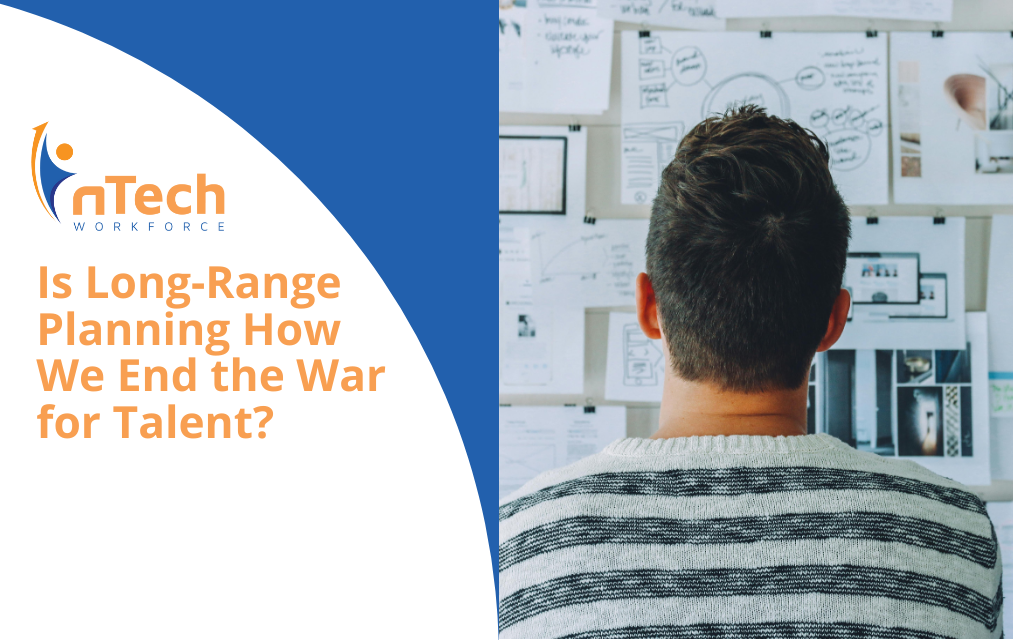Artificial Intelligence (AI) and the Staffing Industry: An Opportunity or a Threat?
While artificial intelligence (AI) continues to drastically change the recruiting and hiring process, experts argue whether these advancements have...
5 min read
Arthur Ransier : Apr 9, 2024 9:00:00 AM

The world of work is in constant flux. New technologies emerge, industries adapt, and the skills needed to succeed are constantly evolving. In this ever-changing landscape, businesses are locked in a fierce battle for top talent.
But what if there's a better way?
This blog explores the power of long-range workforce planning, a strategy that goes beyond short-term needs and focuses on developing talent from within. I am a passionate advocate for economic opportunity. The "war for talent" feels relentless for businesses of all sizes. Hiring costs are skyrocketing, and finding qualified candidates seems like a constant struggle. But what if the answer lies not just in attracting new talent, but in cultivating the potential within your existing workforce?
We'll delve into the downsides of short-term planning, the hidden costs of hiring from scratch, and the compelling reasons to invest in your most valuable asset - your people. By fostering a culture of learning and growth, businesses can not only reduce costs but also build a more loyal and engaged workforce.
As someone who spends his days connecting businesses with exceptional talent, I see firsthand the toll that short-term planning takes on companies. While the pressure to deliver quarterly results is real, a laser focus on immediate needs can have serious long-term consequences. Let's explore some of the downsides of this approach.
In today's competitive landscape, attracting new talent is expensive. From recruiting expenses to onboarding costs, businesses hemorrhage resources when they backfill jobs. Short-term planning often leads to a "revolving door" mentality, where companies prioritize finding quick replacements over-investing in their existing workforce. This constant churn creates a culture of instability, discouraging employee loyalty and hindering the development of valuable institutional knowledge.
A myopic focus on the present blinds businesses to future needs. Rapid technological advancements and evolving consumer demands necessitate a skilled and adaptable workforce. Short-term planning leaves little room for strategic talent development, leading to skill gaps that can cripple a company's ability to innovate or maintain its competitive advantage.
Employees who feel like cogs in a machine, easily replaced by the next warm body, are unlikely to be highly engaged or productive. Short-term planning sends the message that growth and development are not valued. This demotivates employees, hindering innovation and ultimately impacting the company's bottom line.
While short-term planning might offer a temporary sense of control, it's a recipe for long-term disaster. By prioritizing long-range workforce planning, businesses invest in their most valuable asset - their people. This not only reduces costs but also fosters a culture of learning and growth, leading to a more engaged, productive, and ultimately successful workforce.
Delving deeper to uncover the often-hidden costs associated with hiring new talent, it's not just about the base salary; a new hire represents a significant investment for any business.
By understanding both direct and indirect costs, businesses can make informed hiring decisions. Focusing on attracting and retaining top talent can minimize these costs in the long run. This means investing in a strong employer brand, a streamlined recruitment process, and a comprehensive onboarding program. For an even more precise estimate of hiring costs, consider the specific role you're filling and the industry you're in. Industry reports and resources from organizations like SHRM (Society for Human Resource Management) can provide valuable benchmarks.
In today's competitive job market, attracting top talent is crucial. But what about the potential within your existing workforce, particularly entry-level employees? Investing in training and development programs for this group isn't just about altruism; it's a strategic decision with significant benefits for your business.
Reduced turnover, increased productivity, and a more engaged workforce all contribute to a healthier bottom line. By prioritizing long-term workforce planning and development, businesses can create a sustainable competitive advantage and a future filled with success.
Investing in yourself is a strategic move with undeniable benefits. However, it’s important to acknowledge the potential risks associated with this approach and contemplate strategies to mitigate them.
There's always a chance that employees you invest in might leave the company. However, research consistently shows that well-designed development programs lead to significantly lower turnover rates. A study by LinkedIn found that employees who feel their skills are being developed are 4 times less likely to leave. By creating a culture of learning and growth, you foster employee loyalty and engagement, making them more likely to stay and contribute their newfound skills to the organization's success.
The business landscape is constantly evolving, and the skills needed today might not be relevant tomorrow. Investing in the wrong training programs could leave your workforce ill-equipped for future challenges.
Workforce development is an investment in your people. While there are risks, these can be effectively mitigated through strategic planning and a focus on long-term benefits. By prioritizing employee growth and aligning development programs with your future needs, you create a win-win situation. You empower your workforce, reduce turnover costs, and ensure a skilled and adaptable team ready to drive your business forward.
The world of work is changing, and the key to success lies in building a future-proof workforce. By investing in long-range planning and prioritizing the development of your talent, you can unlock a competitive edge and achieve sustainable growth. The choice is clear: investing in your workforce is not an expense, it's an investment in your company's future.
We invite you to continue the conversation. Explore the resources available on the nTech Workforce website, where you'll find valuable insights and practical strategies for building a future-proof workforce. You can also connect with us on social media to join the conversation about workforce development and economic opportunity.
Together, let's build a future of work where everyone has the chance to thrive.

While artificial intelligence (AI) continues to drastically change the recruiting and hiring process, experts argue whether these advancements have...

A bad hire can – and often does – have serious consequences for an organization’s success. For smaller businesses in particular, a five-figure...

Hiring new employees can be stressful because they need to possess the right skills, integrate into the team, and deliver value. A combined approach,...